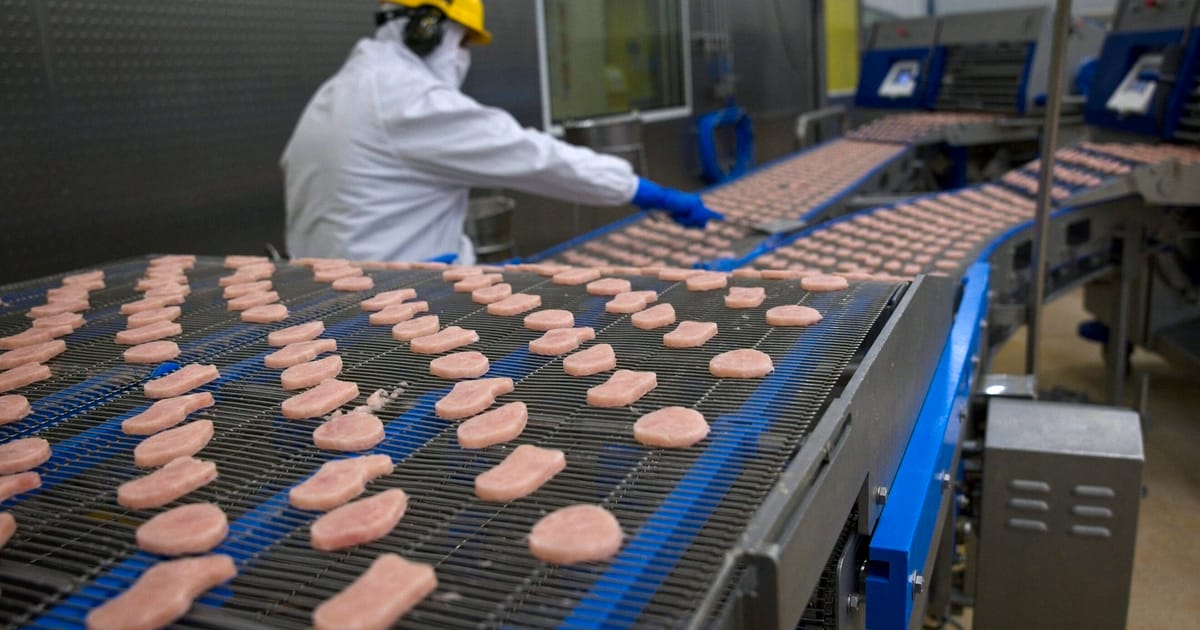“We have to stop destroying the planet as we feed ourselves,” a World Bank official said, as red meat and dairy drive CO2 emissions.
Cows and milk are out, chicken and broccoli are in — if the World Bank has its way, that is.
In a new paper, the international financial lender suggests repurposing the billions rich countries spend to boost CO2-rich products like red meat and dairy for more climate-friendly options like poultry, fruits and vegetables. It’s one of the most cost-effective ways to save the planet from climate change, the bank argues.
The politically touchy recommendation — sure to make certain conservatives and European countries apoplectic — is one of several suggestions the World Bank offers to cut climate-harming pollution from the agricultural and food sectors, which are responsible for nearly a third of global greenhouse gas emissions.
…
The paper comes at a diplomatically strategic moment, as countries signed on to the Paris Agreement — the global pact calling to limit global warming to 1.5 degrees Celsius — prepare to update their climate plans by late 2025.
I cant wait for some conservative idiot to spin this in the worst possible way. Mixed in with some lies, whataubout-isms and straw-mans for a delicious disinformation-coktail!
Iowa did something already last year being a major pork producer. Kim Reynolds and her GOP ilk fucking suck. Already ruined and continuing to destroy a once nice and progressive state with shitty policy and hate. Remember when Iowa was at the front of gay marriage? I miss being proud of at last some of the changes coming from here, now I can’t get if here fast enough. Finally got a WFH position, now I just need to convince my wife that she can fly back to see her parents that live about 3 hours away as is.
Iowa was at the front of gay marriage?
I still can hear the podcasts about America’s growing homosexual corn problem. Even if they never happened.
Florida has already started the “they’re coming for our meat” with the lab grown meat ban if you haven’t seen.
That’s stupid. I’d take lab grown meat, the vegemeats are ok, but I crave real meat and this is best for all. Less land dedicated to animal farming (they can actually graze and live their lives cruelty free) and less farm land for livestock feed(i forget how much land is used to feed our food)? That means even more food grown directly for us, isn’t this the goal?
In Europe soy milk can’t legally be called milk anymore. It’s Soy Drink on the packaging. The farmers won that one. Now they’re coming after vegi burgers allowed to be called burgers.
They won’t win burger or sausage or anything like that. You can already put what you want in those, breadcrumbs, vegetable protein, fruits and vegetables, various flavours and spices, and it’s still a burger/sausage.
The milk I get. Milk was highly controlled in terms of what adultrants were allowed, so when they say “we can’t even add extra aspartame, but they can make the whole thing out of oats?” They get a lot of traction. Now why they wanted to add aspartame I don’t have a fucking clue.
milk-like plant juices or saps have been called milk since 1200. such as milk of magnesia, milk of almond
That’s very true.
I’m just saying that Milk is a regulated term that’s already been used to stop the milk industry from misbehaving so it’s easy for the milk industry to use it to keep out competitors. Burgers, sausages, and other highly mixed foods aren’t regulated the same way and I don’t expect the meat industry to have any success on those fronts outside of rogue states like Florida.
Stuff like this is so silly. I understand having rules around how things are named, nobody wants to be misled about what they’re buying. But were cow juice enthusiasts really getting tricked into buying soy juice? Do we have to specify the animal? Can I sell rat milk as ‘milk’ and they’d be ok? What’s the difference between that and oat milk? So long as the origin of the milk is clear I really don’t see the issue.
Obviously I know it’s just dairy industry deep pockets doing what they can to remain #1 but it’s just so silly.
Well it was originally designed to stop the dairy industry from putting weird stuff in milk, so there definitely a need because they kept trying to put weird stuff in it.
This problem is worse with cheese, using words like “cheese product” or “butter flavoring” for butter. Nobody is getting confused about Oat milk not being from cows, but these “not quite cheese” products are misleading.
That part I understand, no more formaldehyde and brains in the milk. It’s more the industry fighting against the term being used for alternative milks which should have their own standards associated with them. Coconut milk and cream have existed for ages and nobody cares. But my (dairy farmer) family all of a sudden have really strong opinions on using the term milk for alternative milks. Or other generic terms being used for vegan products like mince, sausage, burger, steak. All of these things typically have a word in front to describe what they’re made of, but for some reason certain people get real worked up when that word is ‘vegetable’.
Being a regulator is like being a teacher. There is one kids who keeps putting crayons in his nose so you make a no crayons in your nose rule to stop him and it works great until this one kid uses crayons in nostrils to make amazing pictures for a talent show and suddenly the first kid says “hey I thought you said no nose crayons, why is she allowed crayons now”
The main problem is that it’s actually super hard to have a regulatory definition of “milk” that forces the dairy industry to not put stuff in milk, but also allows up to 100% of the product to be oats.
Vegan steak will be difficult for the same reasons. But I would guess vegan sausage, burgers, nuggets, boneless wings etc… will be very easy to approve since some products are already more fillers than meat already lol!
what’s a better name we could come up with for Soy Drink? we just need a new word
Nut Juice
Legume Malk
I think it now just says SOY or OATS on the packaging. Seems marketing figured out that if you stop the drink you can increase the font size.
Bean Nectar
According to German “what to call stuff that’s not actually juice” rules, assuming for a second that we consider soy a fruit, it’d be “soy nectar”.
I always drink plenty of malk.
But seriously I’ve seen malk and also just “m*lk”.
“Notmilk”? I mean its not milk, and kinda rolls like nut milk
Not “anymore” it never could be called that. Figures that soy beverages are not a product containing excretions of mammary glands.
Next up: You can’t call salt sugar. Oh the tyranny!
…things like coconut milk got grandfathered in based on local usage when the regulation was enacted, in any case that was before Alpro started to sell you 4ct of plants and 0.0001ct of water for three Euros.
My arguments to “if it’s not from an animal or isn’t milk” are:
- What do you call the white liquid inside a coconut?
- What do you call the laxative/antacid that comes in a blue bottle?
That’s coconut water. Coconut milk is made of processed meat!
It would be funny if you just started calling it coconut malk instead of milk. Literally just changing the word milk by one letter.
Malk is rat milk, iirc
- Coconut drink
- Drink of magnesia
It’s just that simple!
/s
Magnesia Julius. Just add nutmeg.
The coco NUT
- Gross
- Also gross
Sounds good to me, I love chicken and veggies!
Same! Well, TBH chicken often tastes gross to me (grew up with a parent that thought ‘boil it in maybe-salted water’ was the way to go). But there’s plenty of non-beef options! Tofu, turkey, textured vegetable protein, it’s all good. (TVP’s great for things like sauces, where you just need the texture of ground beef, but the other flavors would drown it out anyway). Even a peanut butter and jelly sandwich makes for an easy work lunches.
Grilled, baked, and fried are all good ways to try chicken but boiled? Damn, no thanks.
TIL some people never heard of poached chicken. It’s great if you poach it in really strong stock, comes out really moist. Great for shredding or chunks in salad
I think the important bit is “maybe-salted water”. My same parent didn’t like garlic, so I didn’t get exposed to it (or most other seasonings) until college.
Not to worry. My partner is trying to make up for lost time keeps incorporating actually-seasoned chicken into meals. I’m to the point where “well, it tastes good when he does it, but I’ll still not cook chicken for myself or order it in a restaurant”.
TBH chicken often tastes gross to me (grew up with a parent that thought ‘boil it in maybe-salted water’ was the way to go).
Funny, this is why most people hate veggies
It’s kind of funny that I’m very open to all sorts of new goods but still “traumatized” by the overcooked slop I got served as vegetables as a kid. Who knew spinach wasn’t this black slimy stuff from a can, but can be a tasty leafy vegetable?
Yeah, my parents took this approach with veggies too. Luckily it didn’t put me off completely, but I can certainly see how it could.
It’s a shame how many of my parent’s generation just don’t know how to cook anything that isn’t boil it in a pot until it’s soft - it isn’t like the other, tastier methods are difficult or take longer either.
I also suspect an overexposure to canned veggies is also to blame. Canned veggies can be soggy-gross. I really like frozen veggies, though. They fill the same “lasts nearly forever” niche, but with a better texture.
Oh, and kale can go stuff itself. Kale and collard greens are the only two leafy greens I just can’t stand.
Canned green beans are great. I love them mushy, hate them crunchy. No idea why.
Frozen veggies are good, but they don’t always cook the same. Frozen Brussels sprouts fry up great, but I tried roasting them on the grill last night and they just turned mushy. Not sure if it was them or me, but I’ve done fresh ones on the grill just fine.
Ground turkey is actually a surprisingly good ground beef substitute in a number of dishes.
I’ve been using ground pork, chicken, and turkey instead of beef for the most part for a while now. I’ve noticed that when I do use beef, it’s kinda gross compared to the others. Like it can get a bit of a BO smell to it.
It made me realize I don’t even really like beef. I’ve mostly gravitated to instances of it that grind it up and mix with a bunch of spices and stuff like meatballs and burgers. The beef flavour itself isn’t really pleasant, I find.
Well, you might just be buying trash beef.
I still enjoy beef, I’m just eating far less of it than before.
It is possible, but even if there is beef I’d enjoy now, at this point I’d rather go on believing there isn’t. I don’t think I’m missing much.
We use ground turkey almost all the time over ground beef. It’s great in chili, tacos, meat sauce, lasagna, etc. The only time I use ground beef anymore is when I get it free from my folks (they always support a local 4h kid and purchase part of a cow).
We’ve been using ground turkey instead of ground beef for couple of years now, never had a dish where I missed the beef.
may be turned into a culture war battle
May be? Bit optimistic, don’t you think?
Already, more like
Me “not eating pork” is already a political statement to my mom’s side of the family and has been for a at least a decade. A government body recommending less beef? The horror!
Bet they claim there’s not enough land for solar panels, too. If we all eat one or two fewer burgers every week, there’s plenty of land.
As a bonus it’s much healthier. Win win. Though a large portion of the population won’t see it that way.
This is the best summary I could come up with:
In a new paper, the international financial lender suggests repurposing the billions rich countries spend to boost CO2-rich products like red meat and dairy for more climate-friendly options like poultry, fruits and vegetables.
The politically touchy recommendation — sure to make certain conservatives and European countries apoplectic — is one of several suggestions the World Bank offers to cut climate-harming pollution from the agricultural and food sectors, which are responsible for nearly a third of global greenhouse gas emissions.
According to the report, countries must funnel $260 billion each year into those sectors to get serious about erasing their emissions by 2050 — a common goal for developed economies.
Governments can partly plug the gap by reorienting subsidies for red meat and dairy products toward lower-carbon alternatives, the World Bank says.
The switch is one of the most cost-effective ways for wealthy countries — estimated to generate roughly 20 percent of the world’s agri-food emissions — to reduce demand for highly polluting food, it argues.
Food is an “intensely personal choice,” he added, saying he fears that what should be a data-based debate may be turned into a culture war battle.
The original article contains 439 words, the summary contains 187 words. Saved 57%. I’m a bot and I’m open source!
Meat and dairy should be way more expensive in general
It is it’s just paid with tax dollars in many countries
Honestly, it makes sense. Something’s gotta give or we’re all fucked. We should already be eating less red meat and dairy anyway since they’re less healthy than white meat and milk alternatives - adding the economic incentive would be a push in the right direction to be healthier and more eco-friendly.
Beans, chickpeas and lentils are my favorite daily superfoods. So cheap, so tasty, so healthy. Meat is so far in the rearview mirror I don’t even understand the concept anymore.
Any advice for a person who doesn’t really like the mushy texture of beans or chickpeas? I love hummus but I can’t do whole chickpeas.
You can roast them in an airfryer. Chickpeas in particular come out well that way.
Roasted chickpeas with cauliflower is the bomb, especially with some cajun seasoning
I love hummus, too!
- Try black beans and edamame, they are more crunchy.
- Try different brands and put small amounts in every meal and until you get used to it.
- Buy a pressure cooker and cook dried beans yourself. The are cheaper und the texture is so much better! You can cook more than you need and put them in the freezer for later use.
Whole chickpeas do have a disagreeable texture. Black beans and edamame don’t squick me the same way, so maybe give them a try if you haven’t already?
Care to share a favorite recipe or two? I’ve been meaning to step up my legume game for a minute.
Thanks in advance, but also no presh! 🤙
This is not my native language and I’m too lazy to translate whole recipies, so here are just a few tips:
- Cook yellow lentils with vegetable stock to make a creamy sauce, add more stuff and seasoning to taste
- Red lentils stay a bit harder and replace minced meat very well
- Brown lentils with smoked tofu, leek, potatoes, celery and carrots make a great German lentil soup
- Find a recipe for bean chili
- Look for potato and pumpkin-curry
- Throw lentils and chickpeas or beans into tomato sauces and see what you like. There are no rules, I put beans or lentils in every meal!
- Make a fresh salad and toss in cold pasta and beans for a real meal
I really like misr wat. If you can find the berbere spice mix and red lentils I highly recommend it.
Black bean tacos. Whatever you do with beef, use a can of black beans instead
Dried beans are even nicer and cheaper, although I get they require a little more work.
I tried putting black beans on my grill but they fell through the gaps. Help?
No thats okay, the charcoal adds to the texture
I like emerald dol.
Rinse, then soak 1.5 cups of dried lentils for at least 20 mins.
Bring to boil then cover and simmer for 15 minutes in 3.5 cups of water (I just soak them in the pot and turn on the burner). Add 0.5 tsp of salt, turmeric, and chili powder at start of simmer.
Add 1 lb of chopped spinach (I use the frozen blocks for this, basically leave it simmering while they thaw, stirring occasionally to break up the blocks quicker).
In a separate pan, melt 2 tbsp of butter (or whatever equivalent butter-like substance), I add a bit of coconut oil also because I don’t have coconut milk and generally use almond milk instead, so the oil gives it some if that coconut flavour. Chop up an onion and add it to the butter. I also add some fresh garlic and pickled minced ginger, but these are modifications I’ve made to the recipe.
Add 1 tsp of mustard seed and cumin (I use whole cumin seeds but powdered also works).
When the onions are done to your liking (recipe says when they are translucent, but I personally like fresh onions so don’t always cook them that much), add in 0.5 cups of coconut or almond milk (or whatever, even dairy milk would probably work well if we weren’t avoiding it), plus 1 tsp of garam masala and mix all that in to the lentil/spinach pot.
It’s pretty much done at this point, but I’ll keep the (low) heat going for a bit. Watch the moisture level, it should have a consistency of a thick stew.
Put some naan bread in the oven @400 F for ~10 minutes or to however cooked you prefer it. I like to break off pieces and spoon some dol on top as I eat. You can dip it, but it’s too runny to pick up a lot that way.
All measurements are suggestions; pretty sure I use more than that for the spices and one package of frozen spinach blocks is a bit less than a pound (500g).
It scales up pretty well (I usually do a double batch) and freezes well.
India has a lot of vegetarians and a lot of foods that don’t just try to be vegetarian versions of meat dishes, so I suggest checking out more Indian recipes if you’d like more options.
Chicken broth + lentils + whatever veggies you got lying around = tasty as shit soup
Just make sure to wash the lentils first
And to REALLY up your game use a mirepoix as the base.
It’s like telling the people that if you are poor to go fuck themselves and if you are rich they can have anything they want.
Red meat for the rich, white meat for the poor.
We need to reduce animal consumption across the board.
Rich people get stuff that the normals don’t. This isn’t new.
You could also make it more equitable by implementing a carbon tax and returning some of it in the form of cash payments to the poor, and/or investments in infrastructure that benefit the poor the most (health care, public and active transport, welfare).
I’ve heard of that. I think I’ve heard it called “carbon dividend” or something to that effect.
I’m totally for it.
I’m not sure why it’s so difficult to understand. Eating lower down the trophic levels is energy efficient, and the energy level is proportional to environmental destruction, water use, and pollution. This is especially relevant if you have a large population to maintain (food security), which is the case for humans.
Eating up the world’s food web and the human trophic level | PNAS
Abstract
Trophic levels are critical for synthesizing species’ diets, depicting energy pathways, understanding food web dynamics and ecosystem functioning, and monitoring ecosystem health. Specifically, trophic levels describe the position of species in a food web, from primary producers to apex predators (range, 1–5). Small differences in trophic level can reflect large differences in diet. Although trophic levels are among the most basic information collected for animals in ecosystems, a human trophic level (HTL) has never been defined. Here, we find a global HTL of 2.21, i.e., the trophic level of anchoveta. This value has increased with time, consistent with the global trend toward diets higher in meat. National HTLs ranging between 2.04 and 2.57 reflect a broad diversity of diet, although cluster analysis of countries with similar dietary trends reveals only five major groups. We find significant links between socio-economic and environmental indicators and global dietary trends. We demonstrate that the HTL is a synthetic index to monitor human diets and provides a baseline to compare diets between countries.
This first estimate of HTL at 2.21, i.e., a trophic level similar to anchoveta and pigs, quantifies the position of humans in the food web and challenges the perception of humans as top predators (2). Humans dominate ecosystems through changes in land use, biogeochemical cycling, biodiversity, and climate (11, 13, 14). It is not sufficient to separate humans from analyses of ecosystem processes, because there are no remaining ecosystems outside of human influence (15). Thus, investigations of ecosystems, without accounting for the presence of humans, are incomplete (13). There is a variety of other ecological indicators based on trophic ecology theory or diets, e.g., the omnivory index, that may also prove useful in assessing the impact of humans in the functioning of ecosystems. However, a first estimate of an HTL gives us a basic tool that places humans as components of the ecosystem and assists in further comprehending energy pathways, the impact of human resource use, and the structure and functioning of ecosystems.
The global increase in HTL is consistent with the nutrition transition that is expected to continue for several decades (16, 17) from plant-based diets toward diets higher in meat and dairy consumption (18–22). This 0.15 increase in HTL from 1961 to 2009 is mainly due to the increased consumption of fat and meat (SI Appendix, Figs. S5–S8), as opposed to a shift toward the consumption of species with higher trophic levels. In fact, we find that the mean trophic level of terrestrial animals that are consumed by humans has only slightly increased (by 0.01 or 0.5%) due to the higher proportion of pork and poultry in the diet (SI Appendix, Fig. S11_A_), whereas that of marine animals has decreased markedly from 2.88 in 1961 to 2.69 in 2009 (SI Appendix, Fig. S11_B_). This decline in the trophic levels of marine food items in human diets is consistent with the global decline in the mean trophic level of marine fisheries catches. This decline has been related to the consequences of fishing pressures on marine predators (23), although changes in the characteristics of fisheries over time may also influence this trend (24).
The global convergence in HTL is consistent with the convergence in diet structure between countries with diverse levels of development (18, 19), and in agreement with previous studies of the FAO (17, 25). Globalization and economic development facilitate the access to diverse foodstuffs and can enhance the rate of this convergence (18, 26). For India, China, and countries in groups 1–3, HTLs are low and rising. With economic growth, these countries are gaining the ability to support the human preference for high meat diets (18, 19, 26). For countries in group 4, the nutrition transition has reached a point where health problems associated with high fat and meat diets (i.e., high HTLs) have led to changes in policy and government-run education programs that encourage these populations to shift to more plant-based diets [i.e., lower their HTL; SI Appendix, Figs. S4–S8 (18, 20, 22)]. Similarly, countries with high initial HTLs (i.e., group 5) show decreasing trends with time (Fig. 3). For Scandinavian countries, this decline is due to government policies promoting healthier diets (18, 22). For example, in 2011, Sweden consumed historically high levels of meat due to low market prices, leading the Swedish government into discussions of a Pigovian tax to reduce this consumption (27). Changes in diet in Mauritania (decreased meat and dairy consumption) and Mongolia (increased proportion of vegetables) are linked to increased urbanization and economic development and decreased nomadism.
Why do I feel like we’re only going to get the first half?
I’ll stop eating red meat and using plastic straws when there’s no private jets and yachts.
Or just fight back against private jet overusage and giants like Exxon?
How about heavily carbon taxing the rich cunts, hmm?
You know, instead of another bullshit scheme to offset the responsibility of climate change to the majority of the population with the least control over it?
Oh look, more suggestions. Im sure it’ll work this time.
















